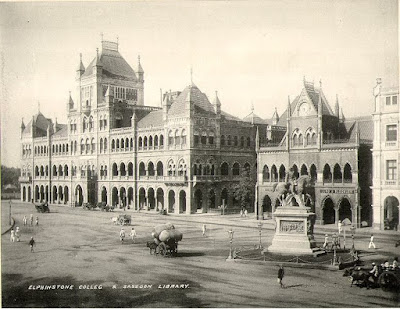At the start of this month I was in
Mumbai, where I spent two and a half weeks working on an exhibition at CSMVS (Chhatrapati Shivaji Maharaj Vastu Sangrahalaya), the former Prince of Wales Museum of
Western India. The exhibition, titled India & the World – A History in Nine Stories (open until 18th
February 2018), is based on the original concept behind Neil MacGregor’s A History of the World in 100 Objects. It
tells the history of India from prehistory to the present situated in the
context of global history, pairing and contrasting objects from India with
similar, contemporary objects from different cultures around the world. There
are some truly gorgeous ancient works of art in this exhibition and many of the
stories told by these objects tell truly fascinating tales of global cross-cultural
connections through trade and exchange, through art and ideas from commodities
and concepts to technologies and teleologies. You can take a virtual tour of
the exhibition and see many of the objects here on the exhibition’s website. And
an article explains more about how the original collaborative idea behind the exhibition
as a means of marking the 70th anniversary of India’s independence came
together here on the British Museum’s blog.
Those two and a half weeks I spent
in Mumbai, working with my colleagues from the BM, CSMVS, and from many other
institutions from across India, was the final stage of several years of
planning and preparation. We had a very full schedule each day which
unfortunately meant there was no downtime in which to explore Mumbai. Most of
what I saw of this historic city was what I encountered on my daily walks from
the hotel to the museum and back again. This walk took me past a few familiar
sites, several of which echoed with colonial era resonances - from the days when Mumbai was Bombay. Each day our route
to the museum took us through the Oval cricket ground – which on Sundays was
packed so tightly with many different teams all playing simultaneously that I
marvelled at how they managed not to get muddled up with one another! Walking
through the cricket ground on these days felt particularly fraught with danger.
In such close proximity it was very hard to resist ducking squeamishly every two seconds on hearing the distinctive thwack of tennis balls on willow!
 |
| The Oval on a weekday - if it were a Sunday you wouldn't be able to see a blade of grass for the crowds of cricketers! |
This walk also took us through the
grounds of Mumbai University, with its tall clock tower reminiscent of far-away
London’s Big Ben, plus the grand old buildings of the David Sassoon Reading
Room, which opened in 1870, and Elphinstone College, founded in 1856 – both of
which put one in mind of London’s equally splendid St. Pancras Railway Station.
One afternoon I did manage to make a detour to see the famous Gateway of India
– the monument erected to commemorate the visit of King George V and Queen Mary
in 1911 on the site where they disembarked for a grand tour of the British Raj,
and through which the British Army departed when India gained its independence
in 1947.
The only other colonial era building
which I managed to visit was possibly all the more interesting for its more
subdued sense of grandeur. Tucked away in the narrow backstreets behind the
CSMVS is Mumbai’s second oldest synagogue. Intrigued by walking past this
crumbling yet impressively large and ornate old building with its flaking sky blue
paint each lunchtime we took a quick peek inside on our last day to find a
magnificent and still functioning interior. The Knesset Eliyahoo, or Knesset
Eliyahu Synagogue, is an Orthodox Jewish synagogue. It was established in 1884
by Jacob Elias Sassoon who named it in honour of his father, Eliyahoo David
Sassoon.
 |
| David Sassoon (1792-1864) |
Jacob’s grandfather, David Sassoon,
was born in Baghdad to a prominent family who later settled in Bombay to escape
the Jewish persecution under Dawud Pasha. In later life David Sassoon went on
to become the leader of Bombay’s émigré Jewish community. Triangulating lucrative
trade links between India, China and the Middle East, Sassoon became a wealthy
businessman, concentrating the family business acumen in the textile industry.
Many of his descendants continued to prosper down the years within the networks
of free trade facilitated by the British Empire. Not all of his descendants
were solely businessmen however; his grandson, David Solomon Sassoon, was a renowned
bibliophile who built up one of the most important collections of Hebrew books
and manuscripts (now sadly dispersed), and his great-grandson was the poet,
Siegfried Sassoon.
It’s a shame I didn’t get the
chance to explore more of the city. This small glimpse of Mumbai’s colonial
past was more than enough to whet my historian’s appetite. And as a first taste
I found Mumbai a madly frenetic city of battered old buses roaring along busy
roads, the air characterised by a cacophony of constantly tooting car horns, all
rushing pell-mell amidst the swirling heat and dust, with thousands of people
packing the pavements on their way to work each day. The poverty is quite
extreme. I saw many people who appeared to find ingenious ways to make a living
out of next to nothing. Some of these people were clearly living very hard lives on
the streets. But what struck me most, whatever their walk-of-life, was how
cheerful and friendly everyone seemed to be. Every chance encountered glance
seemed to burst immediately into warmly radiant and heartfelt smiles which one
couldn’t help but reciprocate. Perhaps this was simply the centuries old charm
of the city. Vibrant and alive. If Mumbai still represents the world’s gateway
to India, then it certainly felt like a wonderfully welcoming place in which to
arrive.







